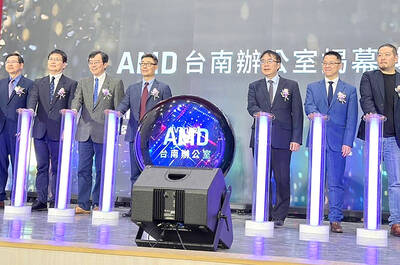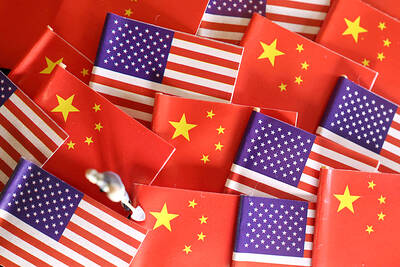The semiconductor sector is expected to benefit from the growth of wearable devices in the next few years, SinoPac Securities Investment Service (永豐投顧) said in a report on Tuesday.
Wearable devices are electronic gadgets that combine computing technology and built-in mobile Internet access with embedded sensors that can respond to the wearer’s movements.
As a result, the availability of various sensors will trigger demand of microelectromechanical systems (MEMS), thereby boosting the proportion of semiconductor components in such devices, SinoPac said.
In October last year, Gartner Inc said MEMS sensors and microcontroller units such as gyroscopes, accelerometers, electronic compasses and pressure sensors would become popular in mobile devices over the next few years, making them one of the major drivers of the global semiconductor industry.
While wearable devices have yet to mature or become a trend, analysts say more smart bracelets, watches and other products are likely to emerge in the next two years to drive growth in the wearable device segment, following in the footsteps of Google Glass, Samsung’s Galaxy Gear smartwatch and Nike’s FuelBand bracelet.
The Industrial Economics and Knowledge Research Center (IEK) has predicted the global market value of wearable devices could reach US$5.5 billion this year, up 83.3 percent from last year.
The figure is estimated to increase 72.7 percent to US$9.5 billion next year and expand another 68.4 percent to US$16 billion in 2016, the Taiwan-based researcher said. By 2018, the global market value of wearable devices is estimated to reach US$35 billion, it said.
Against this backdrop, the proportion of semiconductor components used in wearable devices is estimated to hit 18.3 percent in 2018 from 16.8 percent this year, SinoPac said in the report, citing IEK’s forecast.
The global market value of semiconductor components used in wearable devices will also expand at an annual composite growth rate of 53.2 percent to US$6.41 billion in 2018 from US$920 million this year, the report said.
SinoPac said companies in Taiwan’s semiconductor sector such as wafer foundries and chip packagers were likely to secure outsourcing orders from global integrated device manufacturers in the international MEMS supply chain.
Taiwan Semiconductor Manufacturing Co (台積電), the world’s largest contract chipmaker, Avanced Semiconductor Engineering Inc (ASE, 日月光), the world’s largest chip packaging and testing company, IC testing service provider King Yuan Electronics Co (京元電) and memorychip testing service firm Lingsen Precision Industries Ltd (菱生) are likely to enjoy technological and cost advantages over their domestic peers in the coming years, SinoPac said.
Shares of TSMC closed out the year at NT$105.50 on Tuesday, up 8.76 percent for the whole of last year, while ASE finished the year up 9.92 percent at NT$27.7, according to the Taiwan Stock Exchange’s data. King Yuan rose 10.54 percent over the last 12 months at NT$20.45 and Lingsen moved up 6.6 percent to NT$16.15, the exchange’s data showed.

TECH CLUSTER: The US company’s new office is in the Shalun Smart Green Energy Science City, a new AI industry base and cybersecurity hub in southern Taiwan US chip designer Advanced Micro Devices Inc (AMD) yesterday launched an office in Tainan’s Gueiren District (歸仁), marking a significant milestone in the development of southern Taiwan’s artificial intelligence (AI) industry, the Tainan City Government said in a statement. AMD Taiwan general manager Vincent Chern (陳民皓) presided over the opening ceremony for the company’s new office at the Shalun Smart Green Energy Science City (沙崙智慧綠能科學城), a new AI industry base and cybersecurity hub in southern Taiwan. Facilities in the new office include an information processing center, and a research and development (R&D) center, the Tainan Economic Development Bureau said. The Ministry

ADVERSARIES: The new list includes 11 entities in China and one in Taiwan, which is a local branch of Chinese cloud computing firm Inspur Group The US added dozens of entities to a trade blacklist on Tuesday, the US Department of Commerce said, in part to disrupt Beijing’s artificial intelligence (AI) and advanced computing capabilities. The action affects 80 entities from countries including China, the United Arab Emirates and Iran, with the commerce department citing their “activities contrary to US national security and foreign policy.” Those added to the “entity list” are restricted from obtaining US items and technologies without government authorization. “We will not allow adversaries to exploit American technology to bolster their own militaries and threaten American lives,” US Secretary of Commerce Howard Lutnick said. The entities

Minister of Finance Chuang Tsui-yun (莊翠雲) yesterday told lawmakers that she “would not speculate,” but a “response plan” has been prepared in case Taiwan is targeted by US President Donald Trump’s reciprocal tariffs, which are to be announced on Wednesday next week. The Trump administration, including US Secretary of the Treasury Scott Bessent, has said that much of the proposed reciprocal tariffs would focus on the 15 countries that have the highest trade surpluses with the US. Bessent has referred to those countries as the “dirty 15,” but has not named them. Last year, Taiwan’s US$73.9 billion trade surplus with the US

The Taipei International Cycle Show (Taipei Cycle) yesterday opened at the Taipei Nangang Exhibition Center, with the event’s organizer expecting a steady recovery in the industry this year following a tough last year. This year, 980 companies from 35 countries are participating in the annual bicycle trade show, showcasing technological breakthroughs and market development trends of the bicycle industry at 3,600 booths, the Taiwan External Trade Development Council (TAITRA, 外貿協會) said in a statement. Under the theme “Ride the Revolution,” the exhibition has attracted more than 3,500 international buyers from 80 countries to preregister for the four-day event, which is expected to